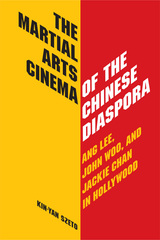2 books about Martial arts films

Experts in Action
Transnational Hong Kong–Style Stunt Work and Performance
Lauren Steimer
Duke University Press, 2021
Action movie stars ranging from Jackie Chan to lesser-known stunt women and men like Zoë Bell and Chad Stahelski stun their audiences with virtuosic martial arts displays, physical prowess, and complex fight sequences. Their performance styles originate from action movies that emerged in the industrial environment of 1980s Hong Kong. In Experts in Action Lauren Steimer examines how Hong Kong--influenced cinema aesthetics and stunt techniques have been taken up, imitated, and reinvented in other locations and production contexts in Hollywood, New Zealand, and Thailand. Foregrounding the transnational circulation of Hong Kong--influenced films, television shows, stars, choreographers, and stunt workers, she shows how stunt workers like Chan, Bell, and others combine techniques from martial arts, dance, Peking opera, and the history of movie and television stunting practices to create embodied performances that are both spectacular and, sometimes, rendered invisible. By describing the training, skills, and labor involved in stunt work as well as the location-dependent material conditions and regulations that impact it, Steimer illuminates the expertise of the workers whose labor is indispensable to some of the world's most popular movies.
[more]

The Martial Arts Cinema of the Chinese Diaspora
Ang Lee, John Woo, and Jackie Chan in Hollywood
Kin-Yan Szeto
Southern Illinois University Press, 2011
In The Martial Arts Cinema of the Chinese Diaspora, Kin-Yan Szeto critically examines three of the most internationally famous martial arts film artists to arise out of the Chinese diaspora and travel far from their homelands to find commercial success in the world at large: Ang Lee, John Woo, and Jackie Chan. Positing the idea that these filmmakers' success is evidence of a "cosmopolitical awareness" arising from their cross-cultural ideological engagements and geopolitical displacements, Szeto demonstrates how this unique perspective allows these three filmmakers to develop and act in the transnational environment of media production, distribution, and consumption.
Beginning with a historical retrospective on Chinese martial arts films as a diasporic film genre and the transnational styles and ideologies of the filmmakers themselves, Szeto uses case studies to explore in depth how the forces of colonialism, Chinese nationalism, and Western imperialism shaped the identities and work of Lee, Woo, and Chan. Addressed in the volume is the groundbreaking martial arts swordplay film that achieves global success-Ang Lee's Crouching Tiger, Hidden Dragon- and its revelations about Hollywood representations of Asians, as well as concepts of male and female masculinity in the swordplay film tradition. Also investigated is the invigoration of contemporary gangster, thriller, and war films by John Woo, whose combination of artistic and historical contexts has contributed to his global success.
Szeto then dissects Chan's mimetic representation of masculinity in his films, and the influences of his Chinese theater and martial arts training on his work. Szeto outlines the similarities and differences between the three artists' films, especially their treatments of gender, sexuality, and power. She concludes by analyzing their films as metaphors for their working conditions in the Chinese diaspora and Hollywood, and demonstrating how through their works, Lee, Woo, and Chan communicate not only with the rest of the world but also with each other.
Far from a book simply about three filmmakers, The Martial Arts Cinema of the Chinese Diaspora investigates the transnational nature of films, the geopolitics of culture and race, and the depths of masculinity and power in movies. Szeto's interdisciplinary approach calls for nothing less than a paradigm shift in the study of Chinese diasporic filmmakers and the embodiment of cosmopolitical perspectives in the martial arts genre.
Beginning with a historical retrospective on Chinese martial arts films as a diasporic film genre and the transnational styles and ideologies of the filmmakers themselves, Szeto uses case studies to explore in depth how the forces of colonialism, Chinese nationalism, and Western imperialism shaped the identities and work of Lee, Woo, and Chan. Addressed in the volume is the groundbreaking martial arts swordplay film that achieves global success-Ang Lee's Crouching Tiger, Hidden Dragon- and its revelations about Hollywood representations of Asians, as well as concepts of male and female masculinity in the swordplay film tradition. Also investigated is the invigoration of contemporary gangster, thriller, and war films by John Woo, whose combination of artistic and historical contexts has contributed to his global success.
Szeto then dissects Chan's mimetic representation of masculinity in his films, and the influences of his Chinese theater and martial arts training on his work. Szeto outlines the similarities and differences between the three artists' films, especially their treatments of gender, sexuality, and power. She concludes by analyzing their films as metaphors for their working conditions in the Chinese diaspora and Hollywood, and demonstrating how through their works, Lee, Woo, and Chan communicate not only with the rest of the world but also with each other.
Far from a book simply about three filmmakers, The Martial Arts Cinema of the Chinese Diaspora investigates the transnational nature of films, the geopolitics of culture and race, and the depths of masculinity and power in movies. Szeto's interdisciplinary approach calls for nothing less than a paradigm shift in the study of Chinese diasporic filmmakers and the embodiment of cosmopolitical perspectives in the martial arts genre.
[more]
READERS
Browse our collection.
PUBLISHERS
See BiblioVault's publisher services.
STUDENT SERVICES
Files for college accessibility offices.
UChicago Accessibility Resources
home | accessibility | search | about | contact us
BiblioVault ® 2001 - 2024
The University of Chicago Press









